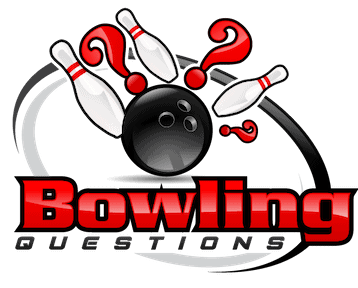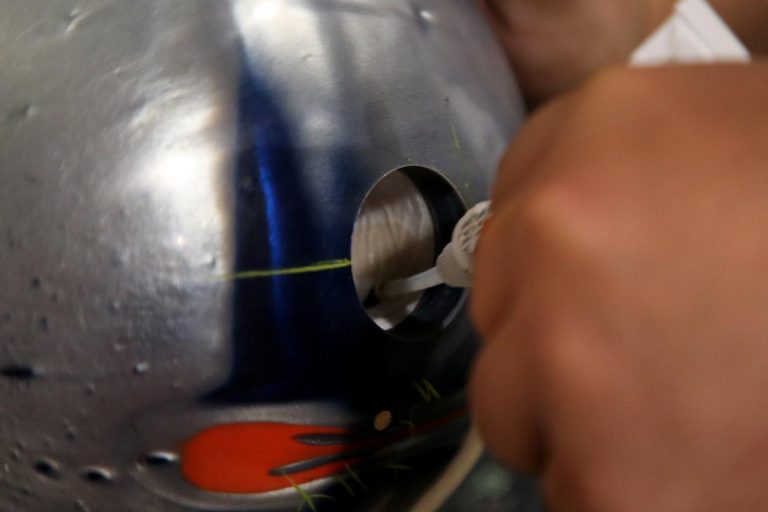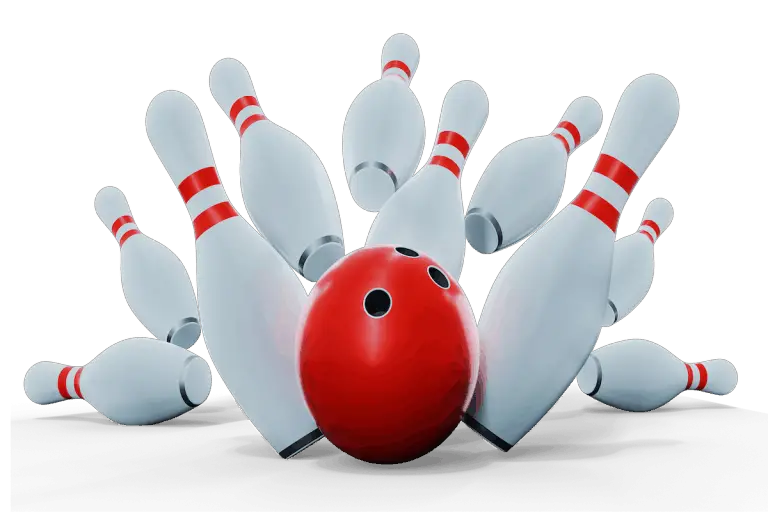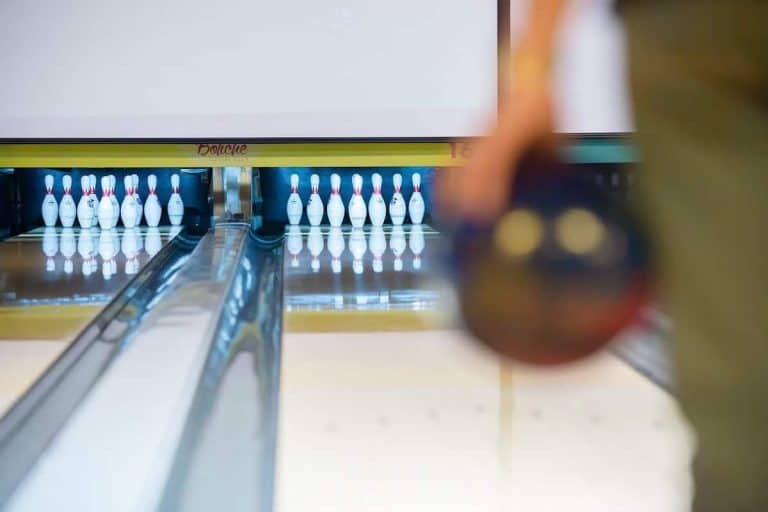How to Spin a Bowling Ball in 11 Steps
Once you’ve become a regular at the bowling alley, it’s only normal that you’ll want to improve your techniques and abandon the newbie tag. Bowling professionals often use various techniques when throwing the ball, the most popular being the bowling spin. Spinning the ball enhances your chances of hitting the pins, thus improving your overall bowling game, so how can you spin a bowling ball?
To spin a bowling ball, you should first find a ball with the right grip. Hold the ball firmly such that your thumb, middle, and ring fingers are well-positioned. Instead of pressing your hand to the ball’s underside, hold it at an angle before releasing your fingers to achieve a good hook.
Curious to learn more about the spin bowling technique? If so, then you couldn’t be in a better place. Read on as we discuss the steps to observe to achieve a successful and effective spin when bowling.
Why Is Spinning a Bowling Ball Important?
As a game of targets, bowling not only requires you to use power to hit the pins, but you’ll also need a lot of precision to hit the pocket and attack the pins at a strategic angle.
The challenge with straight releases is that you’ll have reduced chances of striking the pins. That is, you’ll need to hit the ball with enough power to generate a substantial impact that can bring down the pins. Therefore, unless you hit the angle right, there’s usually no guarantee that you’ll make a solid strike when using the straight release.
However, when you use the spin technique to release the ball, it rotates gently on its axis, tilting upwards as it moves closer to the pins. The tilt gradually reduces as the ball nears the pins. The reduced tilt allows the ball to approach the pins in a hooking motion, which increases the angle of attack, thereby hitting the targets at a strategic angle.
While managing a great swing is not rocket science, you’ll still need to put in a bit of effort to learn a perfect swing. Generally, the better your hook ability, the higher your chances of hitting the pocket and striking several pins.
Achieving a good and effective spin is important when bowling, more so if you want to take your game to the next level. Below are important steps you should observe as you look to master the spinning technique in bowling.
Choose the Right Ball With a Good Grip
A ball that’s good for your opponent isn’t necessarily good for you. When choosing a bowling ball, it’s integral to select one that fits your fingers well. That is, you shouldn’t squeeze your fingers to hold the ball in place, and neither should your fingers stick on the ball’s surface during release.
Finger release is integral in the spinning technique, which essentially means you can’t afford to have your fingers stuck during release. This is because the quality and effectiveness of a spin greatly hinges on the final contact you make with the ball before release.
Therefore, once you hold the ball in place, check on the following to know if the ball makes a good fit.
- Rest the ball on your dominant hand and attempt to place the middle and ring fingers in the side-by-side holes. Place your thumb on the hole beneath the two (side by side) holes.
- Check on how your fingers fit inside the holes. There should be no tension around your thumb and fingers.
- Ideally, it should take little pressure to hold and release the ball. If your fingers are too thick for the holes, try testing another ball until you get one that is neither too tight nor too loose.
Check on the Weight of the Bowling Ball
While it might often come off as a game of chances, bowling is every bit a strategic game like chess. Your first strategy should be finding a ball that you can spin easily. And since finger control is integral when spinning bowling balls, the ball should be light enough for you to hold and release with relative ease.
There are generally two guidelines when looking to find a right-weighted bowling ball. First is the gender of the bowler. Adult women should use slightly lighter balls (10 to 14 pounds or 4.54 to 6.35 kilograms) than 14 to 16 pound (6.35 to 7.26 kilograms) balls for adult men.
If you don’t want to abide by gender-based weight restrictions, the other guideline is to find a ball that’s around 10% your body weight. Either way, you should choose a ball that feels right when held in position. And since ball weight is usually marked on the surface, don’t hesitate to switch to a lighter ball or even a heavier one if it fits well into your palm and fingers.
Assess the Positioning of the Pins
Before you start thinking about spinning the ball, you should first come up with a swinging strategy. A swinging strategy allows you to determine the pocket. In bowling, a pocket is usually the space between two target pins.
For right-handed individuals, the pocket is between number 1 and number 3 pins. The number 1 pin is usually the foremost pin, while the number 3 pin is the one located behind the number 1 pin on the right side.
If you’re left-handed, then the pocket is between number 1 and number 2 pins. The number 2 pin is usually located behind the number 1 pin on the left side.
Amateur bowlers usually throw a straight ball, not giving too much thought to the pocket space. But if you want to make a solid spin, understanding the pocket will allow you to determine the direction of the release.
Hold and Grip the Bowling Ball
Did you know that grip style is crucial to determining the intensity of the bowling ball’s hook? The greater the hook angle, the better your scoring chances, hence the need to choose a ball that you can grip easily.
There are generally three types of grips that you can alternate as you look to pull off a great spin:
- The first grip, commonly called the relaxed grip, usually leads to a minimal hook. For a relaxed grip, the hand bends back at the wrist such that it’s on top of the bowling ball as you transition into the forward swing.
- The second grip is the strong grip, whereby your hand bends slightly forward, as though it’s cradling the ball between your inner wrist and the palm. A well-mustered strong grip should provide enough spin to approach the pocket with a great hook.
- Finally, you can also use a firm grip to produce a moderate hook. In firm grips, the wrist neither flexes nor bends and creates a continuous line between your hand and the forearm.
Determine Your Stance
In bowling, stance plays an integral role in determining a player’s ball delivery. A solid stance position is characterized by body posture, ball-positioning, balance, overall alignment, and leg action. This explains why pro-bowlers usually have a standard pre-shot routine that relies on muscle memory to facilitate effective delivery.
Here’s how you can establish a good stance position to take your bowling game to the next level.
Think About Your Approach
While there are several approaches that you can use when bowling, it’s best to start with the popular four-step approach. Your approach will allow you to improve your overall stance and make more effective deliveries.
As the name suggests, the four-step approach is centered on taking four steps before releasing the ball. And for this approach to work, you’ll need to place your elbow or bowling arm close to your hip. Slightly bend your knee while keeping your feet pointed towards the direction of the pins.
When using the four steps approach, your shoulders should face the front squarely. Observe the following steps as you work on your approach. Disclaimer, the below tips are for right-handed bowlers, meaning lefties should reverse the sides for the tips to apply.
- Take a step forward (right foot) and bring the ball forward to the foot position. Your non-bowling hand should support the ball in this first step.
- Move the left foot slightly forward while lowering the ball to the knee-level position. Move the ball further behind you such that you make a half-circle. Your non-bowling hand shouldn’t be supporting the ball in this step.
- Move forward (right foot), trying to gain momentum, especially in your backswing when holding the ball.
- Take the last step with your left leg. At this point, you should be moving the ball forward, making the most of the momentum you gained in the last step.
- Allow your right leg to pass behind your left leg as you release the ball to prevent your posture from reducing swing quality and direction. Be sure to lower your hips and switch your weight strategically to the back. You should also bend your torso forward, preferably at a 15-20 degree angle.
Approach is important in bowling, hence the need to focus on getting your approach right. While it might be hard to observe the above steps as a newbie, you’ll eventually get the grip of things, provided you practice regularly.
Focus on the Backswing
Contrary to popular belief, twisting or bending the wrist during the backswing doesn’t lead to swings. Instead, it is your delivery and ball release that’ll allow you to spin the ball and make the desired impact. As a result, it is advisable to keep your bowling arm and wrist as straight as possible during the backswing.
During the backswing, keeping an eye on the pocket is highly advised. You should start thinking about spinning the ball once you get closer to releasing the ball.
Delay the Release of the Bowling Ball
As you’re transitioning from the backswing to the forward swing, it’s important to avoid releasing the ball for as long as you can. Ideally, you should release the ball once it passes the laces of your sliding shoe. Please note that, for right-handed bowlers, the sliding shoe should be the left, and vice versa.
Although most people don’t view this step as important, it could go a long way in determining your spin’s effectiveness. Regularly practicing your stance and approach will allow you to capitalize on muscle memory. And as you continue repeating the same routine, your body will naturally adapt, allowing you to make near-perfect spins.
Release the Fingers Starting With the Thumb
As evident by now, the bowling ball spin emanates from finger release instead of twisting or spinning the wrist. No matter which technique you prefer using, you should always start the release with your thumb.
Releasing the thumb as the first finger allows the bowling ball to roll off your hand, which generates enough torque for a spin. Point to note, if you’re relatively new to bowling, you might struggle with the thumb release. But as you continue practicing your throws, you’ll gradually improve your ball release techniques.
Rotate the Wrist Slightly When Releasing the Ball
The rotation doesn’t have to be massive. A 15-20 degrees rotation of the wrist is enough to give the ball a good enough spin. Right-handed bowlers should spin their wrists in a counterclockwise direction, while lefties should spin in a clockwise direction.
As a general rule, the wrist should be positioned as though you’re preparing for a handshake during release. The slight twisting of the wrist, combined with a strategic finger release, should give your ball the spin needed to attack the pocket at the perfect angle.
Continue With the Swing Even After Release
You’ll need to maintain your posture for a couple of seconds after releasing the ball. Once you’ve released the ball, continue moving your bowling arm forward and upward toward the pocket.
Maintaining a solid posture even after release allows the ball to spin in the intended direction. Switching your position immediately after release might interfere with the ball’s direction, consequently messing up your otherwise perfect release.
Practice Regularly and Adjust As Needed
Although most newbies believe that bowling is a game of chance or luck, there’s a lot of behind-the-scenes work that goes into releasing a neatly spinning ball.
You’ll need to get your hands dirty and practice as frequently as possible if you want to improve your spin. While you might muster the art of spinning the ball, you’ll need to work on your hook accuracy when attacking the pocket.
Regular practice will also allow you to get your stance and approach right. Granted, you won’t become an expert spinner overnight, but with a little bit of practice, you’ll soon be intimidating opponents with some pretty neat spins on the lanes.
Tips to Become a Better Bowler
Don’t Assume the Basics
Bawling is a game of precision, meaning you’ll need to time your moves before launching the ball towards the pins. But for you to even come close to hitting the target, it’s crucial to consider some important factors.
First, if you’re using the alley’s balls, you need not be in a hurry to settle for a particular ball. Try out as many balls as possible until you get one that perfectly fits your palm and fingers.
The ideal bowling ball should fit your thumb fairly tightly to give you a steady grip. The middle and ring finger holes shouldn’t be too tight either.
You should also try lifting the balls to determine whether you need a lighter or heavier one. And if professional bowlers use customized balls to enhance their hook on the pins, then working with a well-fitting bowling ball will certainly improve your chances of scoring high.
Check on Your Grip
Grip is everything in the game of bowling. A good enough grip will allow you to manipulate the ball and get an effective spin. Unfortunately, most inexperienced bowlers are often in a rush to throw the ball and attack the pins down the lane.
Instead of rushing to release the ball, take your time to check on your grip, especially if you want to manipulate the throw and do a spin. Ideally, the ball shouldn’t lie on your palm. Instead, it should be in contact with your hand’s upper parts.
For a smooth enough release, it’s vital to spread out your fingers as wide as you can. Avoid inserting your fingers too deep inside the ball as they might get stuck and consequently affect your release. But the thumb should be locked in as deeply as possible for you to have the right level of control.
Capitalize on Muscle Memory
All pro bowlers have their unique routines, approaches, and stances. A routine helps create muscle memory, which allows for a smoother transition from a backswing to the front swing and even the release. The trick is to muster a specific routine and stick with it every time you go bowling.
So, if you want to improve your spin, you’ll need to dedicate some time to developing a unique approach that suits your style. Therefore, don’t be in too much of a hurry to develop a wicked spin. Good things take time, and that accurate spin will come along after consistent practice.
Keep Your Eye on the Pocket
It’s very easy to focus on the front pin. In fact, most first-timers release their balls straight into the number 1 pin in the hopes that the impact will be strong enough to score the other pins.
However, as you’ll notice over time, an accurate bowling shot hinges greatly on how the pocket is attached. Before releasing the ball, be sure to remember the rule of hands. That is, for right-handed individuals, the pocket is between the number 1 and number 3 pins. The number 3 pin is located behind the first pin but towards the right side. However, the pocket is on the opposite side for lefties, between the number 1 and number 2 pins.
Therefore, as you look to become a better bowler, give priority to the pocket instead of the pins. A great release will allow you to hook the pins well by attacking the pocket at a strategic angle.
Work on Your Release
Having a great stance and approach won’t count for much if you don’t have a good release. Unfortunately, releasing a bowling ball isn’t as straightforward as painted by most. Every bowler needs a strategy if they have a powerful and effective release.
For instance, if you’re looking to spin a bowling ball, you’ll need to hold your release until the very last moment. The thumb must first release the ball to allow the ball to roll off your hand and gain momentum before the middle and ring finger releases give the ball further direction.
There is no standard way to release a bowling ball since techniques vary depending on personal preferences. However, to achieve a spin and get a good score, it’s best to work on how you release the ball. Working on your ball release is vital to developing a routine, which also plays a pivotal role in improving your overall performance at the alley.
Straight Bowling vs. Hook Bowling: Which Technique Should You Use?
Straight bowling is arguably the easiest bowling technique, which makes it ideal for first-timers and hobbyist bowlers. Hook bowling, also known as the spin technique, is a strategy used by intermediate to expert bowlers looking to improve their accuracy.
Advantages of Straight Bowling
- Requires little practice to muster. You don’t need tons of experience to hack the straight release technique. All you’ll need to do is swing your arm back and forth like a pendulum and release the ball as you approach the foul line.
- Ideal for power hitters. If you’re the type that relies on power over precision, then you’re best suited for the straight bowling technique. To get a good score, however, you’ll need to keep an eye on the pin and generate as much power as possible to capitalize on impact.
- Ideal for grip practice. We all have to start from somewhere. Straight bowling is a great way to learn how to grip the ball while working on your stance and approach. This technique is often viewed as the spin’s foundation since you must have enough bowling knowledge to pull off the spin technique successfully.
Disadvantages of Straight Bowling
- Difficult to hit all pins. The greatest challenge with the straight release is inconsistency. By relying on power over precision, you won’t be in control over the angle the ball hits the pocket. While you might get lucky and bring down all pins in a single shot, you’ll find it hard to repeat the same shot in the next round. Straight shots depend on the impact to bring down the pins, and impact depends on the power used during release.
- Not ideal for competitions. Professional bowlers rely heavily on spinning the ball as opposed to straight bowling. Using the straight bowling technique in tournaments can prove challenging due to the inconsistency of the releases.
Advantages of Hook Bowling
- Results in fewer splits. Spinning the bowling ball allows players to attack the pockets with great hooks, which results in fewer splits and more strikes.
- Increased accuracy. Hook bowling is more about precision than power. By spinning the ball, you increase the chances of hitting all pins, especially if you manage to hit the pocket at a strategic angle.
- Ideal for competitions. It’s hard to go wrong with the spin technique during tournaments. You’ll have a fair shot at competing with seasoned pros, provided you have a good stance and approach.
- Helps to improve bowling skills. Learning the hook bowling technique allows you to develop crucial bowling skills. This is because hook bowling isn’t straightforward to learn. More so, it is due to the need to have a good stance and muster an approach.
Disadvantages of Hook Bowling
- Not straightforward to learn. Unfortunately, it might take you some time to come to grips with the hook bowling technique. Although not rocket science, learning to spin a bowling ball can prove challenging for first-timers and inexperienced bowlers.
- Works best with customized balls. It’s fairly difficult to spin a bowling ball when using regular alley balls. This explains why most pros prefer using customized balls that snugly fit their fingers and thumbs.
- Requires a chain of events to pull off. Several factors come to play when spinning a bowling ball. Besides choosing the right sized ball, you’ll also need to develop a correct approach that’ll allow you to make a good release. Failure to release the fingers well enough can ruin the entire approach, leading to an unsuccessful throw.
Conclusion
Spinning a bowling ball allows you to attack the pocket at a strategic angle, thus increasing your hook’s effectiveness.
Therefore, as you look to work on your spin, remember to choose a ball that fits your dominant hand well. The holes shouldn’t be too large, and neither should they be too tight on your fingers and thumb.
Your thumb should be first to release the ball such that it rolls across your palm to gain the required torque to spin. And as you release your two fingers, remember to twist your wrist gently as if mimicking a handshake.
Sources
- Bowling Ball: How To Find The Bowling Pocket
- Bowl: Bowling Styles
- Wikihow: Spin A Bowling Ball
- Gaming Weekender: Spin A Bowling Ball
- Beginner Bowling Tips: Bowling With Spin Technique Vs The Straight Ball
- Beginner Bowling Tips: Mastering The Bowling Approach
- Pin Chasers: Quick Tips To Becoming A Better Bowler
- Live Healthy: Straight Bowler Vs Hook Bowler






